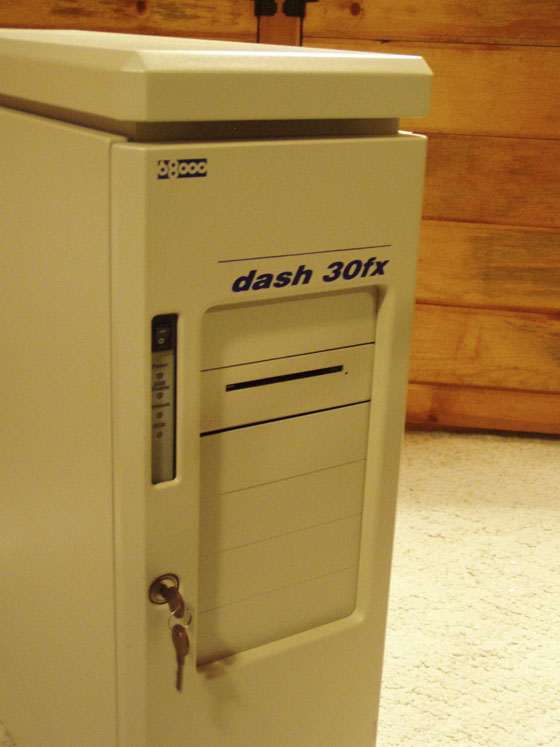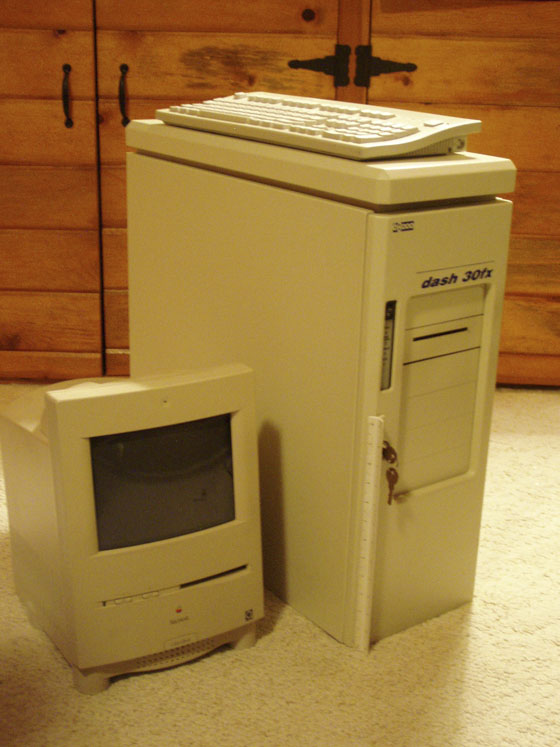Here’s a photo of my latest acquisition; the dash 30fx! The dash is one of the first computers that was “mine” professionally. I moved into the Electronic Prepress area back in ’92 or ’93, and since I was low man on the totem pole, I got the dash.
When it was new, it was the hottest thing available anywhere for any price, and it had a heck of a pricetag; I’m told it cost $40,000. Back in those days it was used as a workstation and an image scanner station. But it soon was outgunned by newer/faster machines. It was sent home with a couple of different employees for use as a training unit, but it was too slow for even that. People get spoiled. It sat in a closet unused for a long time.
I think it was about 2000 when I pulled it out, dusted it off & put it to work as a domain name server for our department. It pulled duty there until early 2005 when I was prepping to leave CCL. It may have been a little selfish of me, but I wanted to take it home, so I made sure it wasn’t doing anything productive when I left. Predictably, it sat there unused until last week when my buddy Jerry stopped by Cimarron & dropped it off. No matter what anybody says, Jerry is OK!
So now I have the behemoth at home. Here’s a photo of it standing next to a Color Classic to give you an idea of its size; it is monstrous.
A funny thing happened with it when I got it home, and is a testament to it’s durability. I was carrying it in the house from the garage, holding it by the top lid at the back and the lip on the door above the drive bays on the front. The door must’ve shifted a little bit which allowed the top to shift a little bit which allowed the top to come loose. The top stayed in my hand but the rest of the machine came crashing down on the threshold of the garage doorway.
Bang!
The result wasn’t as bad as I thought it would be. The doorway threshold took the worst of it; two creases where the case hit. The case only had a minor scuff line across the bottom where it impacted the metal threshold. Inside, one of the Nubus cards got knocked loose, as did some of the RAM cards. I’m glad it didn’t come down on my bare foot; I’m sure that would’ve put me in the hospital!
Once I put it back together (and snapped a few photos of it) I plugged it in & it booted right up. No damage done. Yup; built like a tank. Wonder if a new Mac Pro could handle a fall with that kind of aplomb.


I did some digging around the ‘net & found a little more info. I’ll add more comments as I learn more.
This one is from a really old Seybold Report.
This one comes from a personal homepage run by Marc Schrier on dot Mac:
This comes from what appears to be an annual report from The Cole Group:
I’ll have to see what I can find relating to ImagiTex.
This one is from Low End Mac. I provided LEM with the photos and some of the information they have a while back while still at CCL.
This is a comment from an eBay forum by user zoramason, dated September 30, 2005.
I’ve sent a message to that guy, and will post more info as I get it.
This must’ve been a memorable item for zoramason, as I just bumped into another reference from him.
I sent a note to zoramason, and he took the time to write back. A decent chap by the name of Shannon Mason, from somewhere in Oregon.
Found the original product announcement, from Computing Canada, May 23, 1991. That doesn’t really seem all that long ago. Boy do I feel old some days.
Room for “up to 10GB of disk storage.” That’s good. I get worried when I have only 10GB available on my laptop hard drive.
Just an update to the doorway drop story; I was snapping some photos of it last night & noticed that the hard drive was slightly askew in its mounting brackets.
The brackets are a set of modular rails that mount on either side of the drive mechanism, adding sufficient width to get the drive to fit between the mounting rails built into the case. I pulled the drive out to see if it had just shifted or what the problem was, and discovered that the aluminum frame that is attached to the drive actually broke in two places. Holy cow! That was quite a shock.
The night of the incident I noticed that the floppy drive was a little crooked, but that had just shifted a little in the rails; easy fix. The hard drive though; that’s gonna be a little tougher.
I finally got around to scanning the User Manual and RAM Installation Guide for this machine. The searchable PDF’s can be found here and here.
I had been complaining about not having a scanner set up to do this job — the only scanner I have has a SCSI interface, and I don’t have any older Macs with SCSI set up — but yesterday it dawned on me that I was walking by the solution to that problem a number of times every day. We got a new Kyocera Mita network scanner/copier/printer at work a while back that will scan documents to a file. It took about 5 minutes to scan both sides of the pages from these manuals, and the image quality is excellent. It actually took longer for Acrobat to OCR the files to make them searchable.
Dang! Ain’t technology great?
Good site Dave, just surfing around as I was wondering if it was such a great idea to trash my dash 30fx (did it a couple of years a go)
I remember fondly running one of the first ProTools TDM systems on my dash, and it worked real well. I guess the bigest problem with the machine was it’s expensive RAM I had 20MB in mine and could never stomach paying out £500 odd for a meaningful upgrade!!
I worked at Syco in the early 90’s (one of the only 6800 supliers in our country) and there was also a machine called the 40Q, which was an overclocked quadra 950 in a very very large case. We used to sell them as an upgrade for the quadra 950, and our last one sat in the stock room unsold for a good few years, eventually when it was sold it was my job to build it, the crystal on the motherboard was over clocked with a pretty crappy clip on … all looked pretty impresive when it was running however.
There were a few upgrades for the 30fx as i remember I had a PDS slot scsi card called the ‘bolt’ when you booted up with a drive on it, you had a cool shark type icon as the firmware loaded in…ahhh happy days 😉
On the subject of the dash case durability, I used to do tech support for 68ooo/ARRISystems and I remember one of the guys in production taking a dash 30fx case to the rifle range for target practice. He hit the front door near the logos as I recall and the bullet didn’t even go through!, just a big dent…so these things were actually bullet-proof!
The 32MB SIMMs for dash 30fx custom manufactured by a supplier off of Colemen Ave. in San Jose. I can’t remember the name, but the sales rep left to work for this company:
http://www.memoryx.com/
They generated a lot of heat, so there was this contraption we called “the doghouse” that enclosed the RAM had a fan dedicated to cooling it off.
As I recall, the 68ooo products were:
The dash 30fx (the above mentioned, overclocked IIfx in a serious case with a beefy power supply)
The SCSI Bolt (SCSI Card – I believe this also had a differential SCSI connector that allowed linking two machines for high speed data transfers)
The dash 40Q (based on the Quadra 950, had a faster ‘040 on a daughter card with a switch to enable the faster clock)
The RAID Warrior (‘040 PDS RAID card)
The Imagician (Photoshop acceleration card) – I don’t know if this ever shipped. They laid us all off for Christmas that year.
The Hurricane (this might have been the same as the Imagician, I can’t remember…)
The threat of Radius’ Skylab project and Apple’s switch to the PowerPC processor was the death of the company.
Here’s more 68ooo company info:
—
http://findarticles.com/p/articles/mi_m0NEW/is_1992_August_27/ai_12585557
Macintosh Corporation changes name to Sixty Eight Thousand
Newsbytes News Network, August 27, 1992 by Ian Stokell
(this is a long article, so I won’t quote it here…)
—
http://www.colepapers.net/tcp.archive/cole_papers_91-94/TCP9206.html
From “The Cole Papers” June 1992 Vol. 3, No. 6
49. Sixty Eight Thousand Inc.: Speedy Macintoshes are this company’s forte, taking its name from the Motorola 68000 processor that drives the Mac. But the company’s newest product, the Hurricane, uses an Intel Risc chip, the i860xp, to achieve a 10- to 20-fold speed increase in such applications as applying PhotoShop filters. Sharing the booth will be Advanced Gateway Solutions, showing its ScanMate Plus desktop scanner, which uses PMT technology and will go for $30,000. (408) 438-1777.
——
http://sec.edgar-online.com/1998/04/15/17/0001001277-98-000037/Section11.asp
In June 1994, Sixty-Eight Thousand, Inc., a company which made Macintosh compatible workstations, filed for bankruptcy protection in San Jose, California (Case No.: 94-54123).
—-
Hey Guys,
I don´t know, if it is interesting for you.
I´ve some nice pictures on my website (favorites)
from two dash-towers. I´ve modded them aktually wih 2 G% Mac´s and one PC. The third one is dark green.
Marcus
http://www.marcust.de
Just a quick update; since this machine has been sitting in my basement unused, I’m thinking of selling it and all the paperwork that came with it. Will likely start an eBay auction on it soon. We’ll see where it goes!